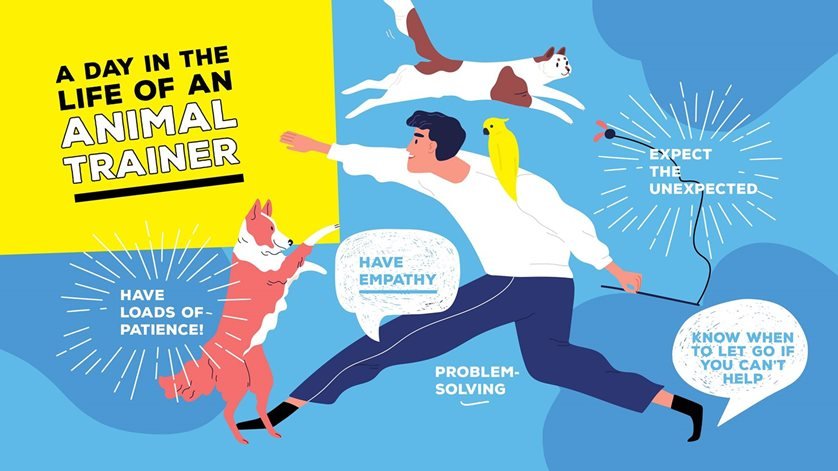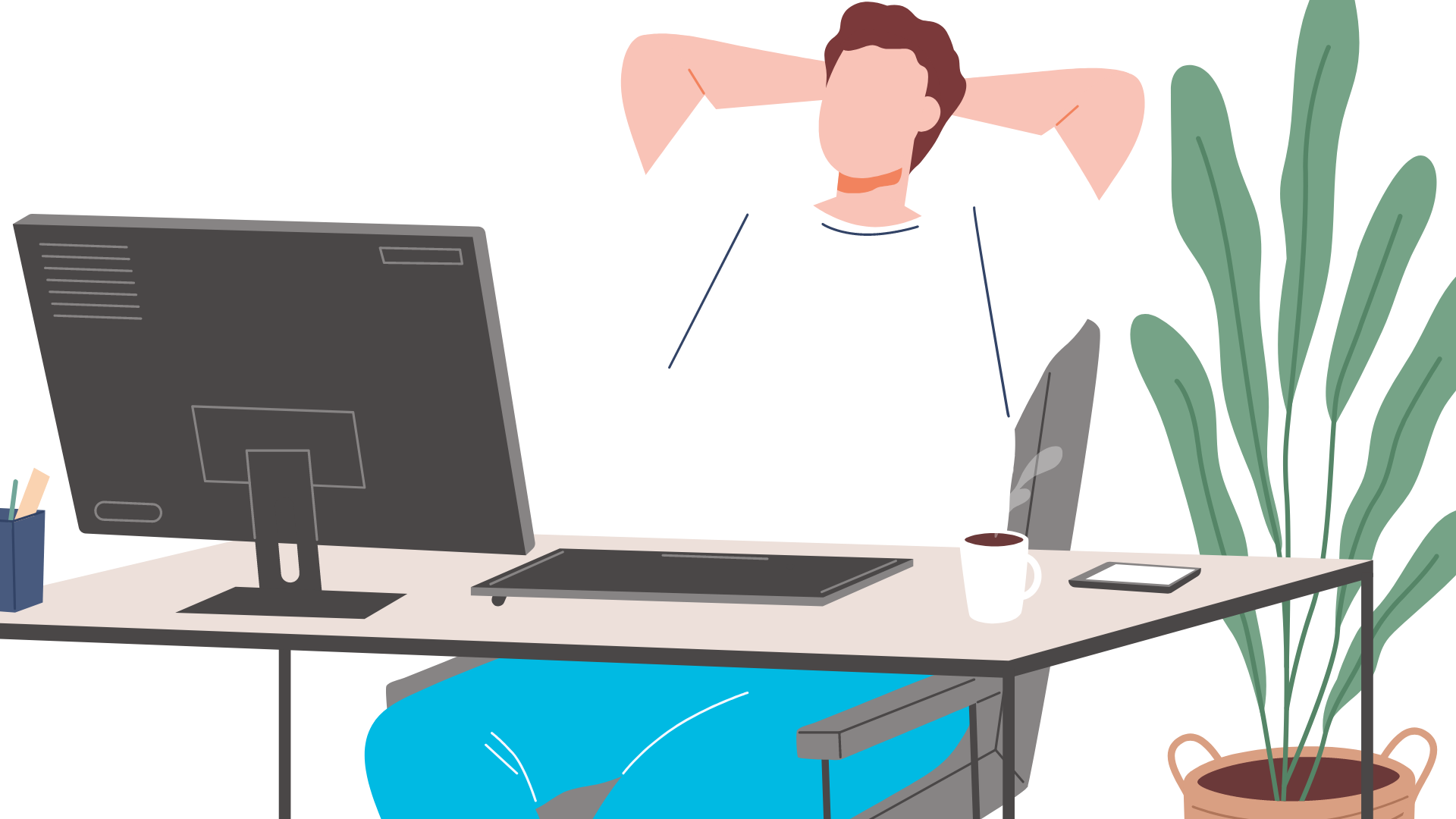A Day in the Life Of...
An Animal Trainer
By Donnay Torr

Patrick Richards is a guy who’s passionate about parrots (and budgies and galahs and conures and well pretty much all birds...) So lucky for him it turns out that his natural skills include being a bird whisperer of sorts! Patrick shared more about his current job as an intern Parrot Behaviour Consultant at Parrot Life Behaviour and Training.

PATRICK RICHARDS: ANIMAL TRAINER

Can you describe a typical day on the job?
I wouldn’t really say that any day could be defined as typical. Clients contact us if they are having a behavioural or training challenge with their pet birds. We develop a rough training plan on how to best address their issue and organise a time to meet them in their home to implement this plan. We then assess the progress we have made and may continue with ongoing consultations write up a step-by-step training plan for them and check on their progress at a later time.
No two consults are ever really the same. If a client has minimal to zero experience working with positive training methods we will usually spend a good amount of time helping them understand the science behind and the mechanics of the methods we are going to help them apply to their training and husbandry. Sometimes a client will have a very advanced knowledge so the bulk of the consult will be working with the bird and the client together. Sometimes a bird does not actually require training but the behavioural issues we have been contacted about are the result of an undiagnosed illness or a hormone imbalance created by a poor diet and/or sleeping pattern.
No two days are ever the same and that is one of the best things about the job.
Why did you choose to become an animal trainer?
Growing up my family always had a lot of pets. Cats dogs birds chickens alpacas – if you can name it we’ve probably cared for it. I have always had an enormous respect and appreciation for animals in captivity and have wanted to help them. Having said that working with animals was not really something that I considered doing as a career until I started working in the field of animal behaviour.
I was working as a casual in the bird section of a pet store while I finished up my Ancient History degree (no I haven’t used it but I am still very glad that I did it!) and I had a new manager start. Unbeknownst to me at the time he was a bit of a legend in the pet industry and he took me under his wing. He realised that I had a real knack for observing the behaviour and body language of the birds and adjusting how I interacted with them around the information they were giving me.
He put me in contact with an animal trainer he had known for a long time to learn more about how to apply my abilities. This trainer happened to be one of the best and most accomplished positive reinforcement focused trainers in the country (I didn’t know that at the time either!). She taught me the basics of positive Operant Conditioning training methods and my work after that point just took off.
Having the ability to communicate with and train the birds in my care just added a whole new layer to the job.
If I had a bird who showed signs of stress when having his vegetable bowl removed I could develop and implement a training plan to make this daily occurrence more positive and less frightening. If I had a baby bird who was frightened of hands I could desensitise and counter-condition that bird so that it began to see hands as not only non-aversive but exciting and full of opportunity.
Understanding and working with behaviour allowed me to fundamentally change my perspective on animal husbandry. Things that used to be problems or ‘just a sad part of the job’ were now opportunities to help change and improve the birds’ lives and it was this that inspired me and continues to inspire me everyday.
What are three key personality aspects or skills that make for a good florist?
This is a challenging question to answer as I don’t want to pigeonhole anyone (nice little bird pun there for you!) but there are definitely aspects that I see in myself and also see in the majority of my colleagues.
- Empathy:Training is an emotionally draining job. Unfortunately, most of the birds that we come across are not overwhelmingly happy, well-adjusted animals with control over their environments. It is important to remember that no client who contacts us is trying in any way to do the wrong thing by their birds, in fact they prove that by contacting a professional service for assistance. More often than not the issues that we are addressing are the result of a communication blockage or breakdown between an owner and their pet, which often leads to a cycle of compounding frustration for both parties. This is why empathy is so important. You need to be able to understand and empathise not just with the animal but also with the owner as having a pet that is in your care be unhappy often takes as big a toll on them as it does on their pet. You are working with them both and must be there for them both.
- Patience: To be an effective trainer you must be patient. Every animal and its owner is an individual and they bring their own levels of motivation, training history and emotion to each consult or training session. It can often feel frustrating as a trainer because you want to get results quickly or you may have a client who wants to fix a behavioural issue that has developed over several years in a week but it all comes back to patience. Patience in yourself, with your clients and most importantly with the animals.
- The ability to let go: If you have read the above traits and though to yourself ‘I have those’, then this last one is perhaps the most important. You must be able to understand that you cannot help them all. There are some animals in situations where success cannot be achieved. The same applies to some owners. There are also some training problems that will be beyond your skillset or ability so you must not be afraid to let go and refer these on to someone with required ability.What have you learned about yourself through the work that you do?
What have you learned about yourself through the work that you do?
I have learned that learning is in itself the greatest reward there is. Perhaps my favourite thing about positive training methods is that while yes, they are a science, they are a relatively new science and as a result new discoveries are being made every day. Every consult I do, every client I speak with, every bird I work with teaches me something new that I can then apply to the next. Every day I get better and what the animals and I can then achieve gets better.
I never knew that I thrived on self improvement the way that I do.
I have also learned about my ability to look at a problem or a situation as a whole and to not make pre-determined judgements. When someone tells you that their dog growls at their kids it is easy to make the assumption that either the dog is aggressive or the child is too full on.
If a bird doesn’t want to go back in its cage and retreats to the owner’s shoulder when asked to do so, and then bites them on the ear, it is easy to say the bird is dominant and disobedient.
Learning to see behaviour as the result of environment, physical and emotional health, prior learning and history and species-specific behaviour allows you to then say that the dog who growls at kids may have an undiagnosed skin condition that causes pain when he has his head stroked.
Maybe that bird who is disobedient and dominant has a caged environment that is devoid of opportunities to play and make meaningful choices, so of course he does not want to go back in there! Running up the owners’ arm and biting their ear results in a few more precious moments out of their cage. I have learned to apply this thinking to interactions I have with all people and animals and I believe I am a better person for it.
How do you keep going when things get really tough?
The results that you can get with positive training are so reinforcing that they alone usually power me forward. However, there are days where you make a mistake or misunderstand an animal’s motivation or don’t show enough empathy to a client or just come across a situation that breaks your heart.
In times like these I remind myself that no animal in captivity has made a choice to be in captivity. They are either born into it or come into it via circumstance. As a result it is our job to make the life they did not choose as rewarding and as positive as possible and to give them as much agency and choice over what happens in their environment as we can.
I am lucky to possess the skillset that I do and I am even luckier to be able to work with animals. Knowing this will always keep me motivated.
Can you share a funny or weird story about something you experienced while working on a project?
Early on in my education I worked with a Sun Conure who inadvertently taught me a great deal about bridge timing. I had conditioned this fourteen-week-old conure with a clicker as a bridge. Put simply: click=food, therefore the behaviour being performed when the click is heard is the behaviour that is earning me a reward. The clicker acts a bridge between behaviour and the reward.
I was still working in the pet store and I had the conure on a perch and was teaching him to step up on my hand. Present my hand. He placed both feet on it. Click. Reward. This is a simple and fundamental behaviour for pet birds and he understood it well. I had amassed a bit of a crowd of people watching, some of whom began to ask questions about what I was doing so therefore I, with my two months’ of knowledge thinking I was an expert, began to tell them all about it.
As I was demonstrating how the clicker worked, a child got a little too close to the bird, who then dropped down the back of the perch and held his beak open moving his head back and forth. A fairly typical warning sign. It was at this moment, not observing the bird, that I clicked and delivered a treat. I had just unintentionally captured a new behaviour.
From then on whenever I presented a hand the bird would drop back and wiggle his head which would cause the crowd to laugh, which acted as a reinforcer for the bird, which made him only want to perform the behaviour more.
It was a good learning opportunity as I learned how to go back a few steps in training and begin again. But it was certainly embarrassing for me and confusing for the bird!
